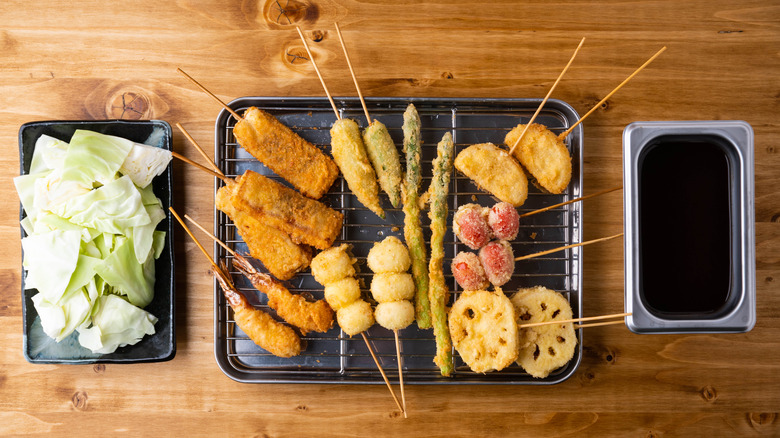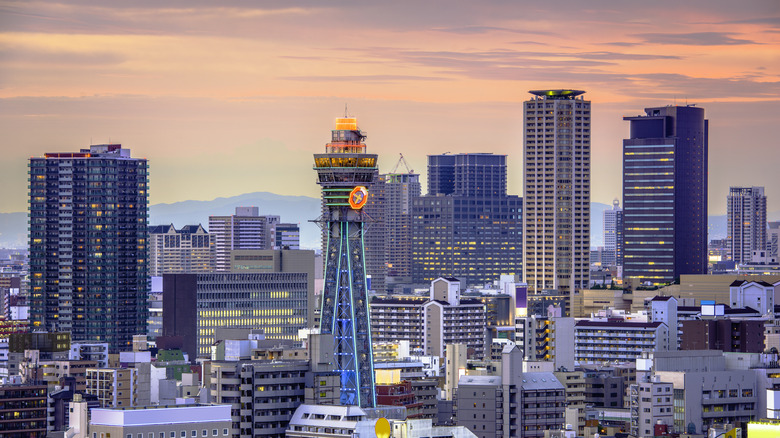Kushiage: Panko Gives This Japanese Street Food Extra Crispiness
If you ever find yourself roaming the streets of a city in Japan, we're sure you've already curated quite a checklist of the country's iconic foods. And when it comes to choosing where to eat all this good food, you don't have to spend a fortune. In fact, Japan boasts some of the finest street food in the world, and when it comes to deep-fried cravings, you don't have to miss out with kushiage in the mix.
Kushiage, also known as kushikatsu, is a casual eatery dish that showcases deep-fried panko-covered meat and vegetables on a stick. When paired with its delectable sauce, you'd never believe this now-popular snack had such humble beginnings. Whether you're stopping at a hole-in-the-wall izakaya (a boisterous establishment where you can drink alcohol and eat casual bites among friends) or frequenting street food stalls, you're guaranteed to run into this snack-like meal that is full of flavor and crunch.
History of kushiage
While many of Japan's bustling cities have great street food options available, the city of Osaka has long been considered the "street food capital of the country" (via Japan Wonder Travel). So it's no surprise that kushiage originated from this region of Japan. The dish was invented in the early part of the 20th century in Osaka when it was simply a dish doled out to working-class laborers. In retrospect, and even by today's standards, it is a fast and cheap meal that is filling enough to enjoy.
Kushiage can still be found on the streets feeding modern-day workers in a rush, school children, and anyone looking for a low-cost yet satiating meal. Today, you can find elevated versions of this dish that are created to serve populations frequenting fancier establishments. But, most often, it is still served as the bite-sized, deep-fried snack it always was, with simple ingredients and uncomplicated construction.
Ingredients in kushiage
There is an endless list of tasty options for choosing which kushiage skewer to grab from a nearby street food vendor. All kinds of meat, seafood, vegetables, and other bite-sized ingredients commonly get speared, coated in panko breadcrumbs, and fried to make a delicious meal. When it comes to meat options, beef, pork, chicken, and sausage are some of the most popular. However, horse meat, quail eggs, and other protein-packed ingredients also can make an appearance on izakaya and street stall menus.
Seafood kushiage often features shrimp, oysters, and octopus, while various fish, like mackerel and smelt, can also be lighter options. If you're a vegetarian, there are plenty of vegetables to choose from, such as lotus root, asparagus, tomato, okra, bamboo shoots, and mushrooms. For fun variety and texture, you may even see some deep-fried mochi, cheese, and fish cake.
While you may be unsure of which versions to try while out on the streets of Japan, you can make them at home instead — that way, you can pick your favorite foods to chop up and fry.
How kushiage is made and eaten
Making fresh kushiage is a simple process, and it's quick enough to create for any last-minute event you may be hosting. The first step is to slice your selected meat or vegetables into bite-sized pieces. The segments then get placed onto the skewers, coated in flour and egg batter, and dipped in breadcrumbs. Once the skewer is properly assembled, the meat and vegetables get placed into hot oil and deep-fried for a couple of minutes. Your kushiage will emerge golden brown, and it can be eaten once it's cooled down.
Since kushiage is a typical street food, it should be eaten right off the stick. It's often paired with a tangy Worcestershire-based sauce known as tonkatsu sauce and a side of crunchy cabbage. It is important to note that if you're served a communal dish of sauce at a sit-down restaurant, it's bad manners to dip your food straight into the sauce-filled bowl. You should always scoop out your own portion and place it onto your plate. Once you're finished eating, make sure to wash it down with a fresh Japanese lager for an authentic experience.
You'll have no trouble finding kushiage at a myriad of street food stalls, izakayas, and even dedicated kushiage restaurants in Osaka. However, you may also find this dish in select Japanese restaurants in the U.S. as well.



